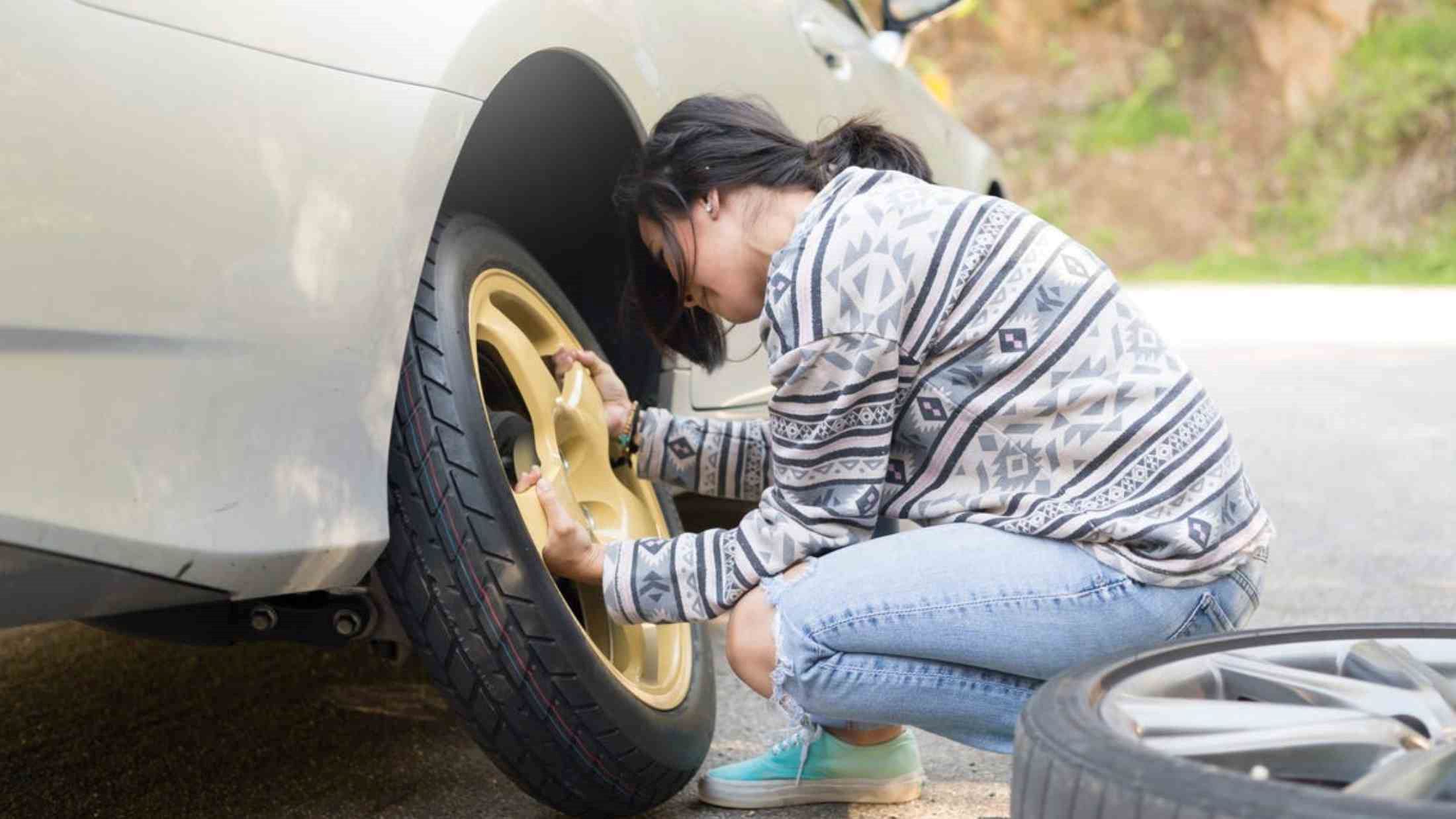Flat tyres and how to avoid them
A flat tyre can happen at any time. It doesn’t matter what kind of car you drive, it can happen to you. In fact Highways England says that one in five motorway breakdowns are caused by worn or incorrectly inflated tyres.
So, how do you spot them before they become a problem?
What to look out for
Once you know that most flats are slow burners, they get a lot easier to spot. All it takes is a minor imperfection in the tyre. A slow release of air over time. And hello flat tyre.
The four signs it’s about to happen are:
Low pressure
If the pressure drops suddenly or appears to go down each day, you’re on your way to a flat tyre.
Just one in six drivers bother to check their tyres before setting off on a long journey. So don’t be one of the five. Make it a habit and don’t forget the spare! Heavy loads and extra passengers can also make a big difference, so check your tyre pressure guide.
(You can find the recommended tyre pressure inside the fuel filler flap, on the drivers’ door edge or in your vehicle’s handbook.)
Worn out tread
The more tread you have, the better the hold your tyre will have on the road, particularly if it’s wet.
Here in the UK, the legal minimum for tyre tread depth is at least 1.6mm. Any less and you’re at risk of a flat. If you’re stopped by police you could also find yourself with 3 points and a fine of up to £2,500.
You can pick up a tread depth gauge for less than a fiver. Or, failing that, get a 20p piece and push it in between the grooves in the tread. If the coin’s raised outer edge is visible, the tyre needs replacing.
Wheel shake
Steering wheel shake can be caused by a lot of issues including unbalanced and misaligned tyres. Typically you’ll notice them when you hit speed of 50mph and above.
Our best advice is to take the car in for a diagnostic service straight away. Another way to spot unbalanced wheels is by looking for signs of uneven or excessive wear.
Cuts, bulges and blisters
Luckily you don’t have to be an expert to spot a fault in the tyre. If you do find something make sure you replace the tyre immediately as it could result in a blowout.
What to do when you get a flat
It doesn’t matter how careful you are, flats do happen. So what do you do?
If you have breakdown cover with AXA you can relax. We’ll replace faulty tyres for you, both at home and when you’re on the road.
There are basically two types of flat:
A blowout
This usually happens when something sharp has caused your tyre to rupture. If this is the case you’ll have no choice but to pull aside and stop. At which point your first priority is safety for you, your passengers and any other traffic nearby.
Once safe you’re free to call your breakdown service, whether that’s AXA Assistance or, if you don’t have a breakdown service, a local recovery firm. If the car is in a place which could lead to an accident, then we also advise calling the local police.
A slow puncture
With a slow puncture you have more leeway. Especially if your car come with what’s known as ‘run flat tyres, which can be driven on for short periods with no air. It’s well worth asking your dealer or your local garage if you have them.
If you’re on a motorway – especially one without a hard shoulder - try to get to a Service Area, or failing that, an Emergency Refuge Area (ERA), where you’re well away from moving vehicles.
You can often ‘feel’ when a flat is about to happen as the car starts to drag to one side, or it feels a bit wobbly when you turn a corner.
Drop your speed and take it easy on corners so you can get to that place of safety before the tyre gets any worse.
Whichever kind of flat you have, hopefully you will have familiarised yourself with the Highway Code beforehand.
Passengers should only alight on the side of the car away from moving traffic and find somewhere safe where they can wait for help. The rules state that you mustn’t stop on any carriageway, emergency area, hard shoulder, slip road, central reservation or verge - except in an emergency. Obviously a blow-out qualifies as an emergency.
They also advise that drivers only to “change the tyre if you can do so without putting yourself or others at risk – otherwise call a breakdown service.”
And don't change the tyre in the dark. Even with a reflective vest, and a warning triangle, oncoming traffic might find you hard to spot. So, if you're not entirely sure it's safe to change a tyre, call a breakdown service.
Never drive on a flat tyre
Our number one piece of advice is don’t drive on a flat. You’ll ruin the wheel rim, which is a lot more expensive to repair than a simple flat.
How to replace a tyre
If you’ve never replaced a tyre before we recommend watching a quick ‘how to video’ online, ideally one that’s for your make and model.
In the meantime, here’s a step-by-step guide.
- Safety first - make sure you’re in a safe space away from traffic
- Warning triangle - put out a warning triangle if there’s likely to be oncoming traffic
- Lighten the load - make sure there are no passengers or heavy luggage in the rear
- Check your tools - they should include: a spare wheel (fully inflated), a wheel brace (tubular bent rod), a wheel nut key (round with flat edges on the inside), jack and ideally a high-vis jacket.
- Loosen the nuts - remove the trim (decorative cover) on the wheel then loosen the wheel nuts slightly in an anti-clockwise direction.
- Jack it up - position the jack under the car close to the wheel you want to change, then raise it slowly using the jack till the wheel is about 10-15cm (4-6 inches) off the ground.
- Remove the wheel - undo the wheel nuts completely and pull off the wheel. This will be heavy so you might want to ask for help.
- Put on the spare - slide the spare wheel onto the hub bolts, replace the nuts and tighten them by hand.
- Lower the car - just so it’s in touch with the ground and tighten the nuts with the tools you used in step 5.
- Almost done - now lower the car completely and slide out the jack. Check your nuts are tight one final time, and pop any tools and the old wheel in the boot. If you have a tyre pressure gauge check the pressure.
After changing the tyre, you should drive to a garage where they can either repair your old tyre or replace it with a new one. Don’t use the spare for longer than you need to, as they aren’t designed for everyday use or high speeds.
That’s it.
Flat tyre and no spare?
If your car isn’t designed to carry a spare wheel there are some excellent temporary fixes available – tyre foam, puncture repair kits and tyre inflation kits.
Whichever one you choose to carry around with you, please bear in mind they’re designed to get you to the nearest garage. We haven’t gone into detail here, so you’ll need to check the manufacturer’s instructions, but their main benefits are as follows:
Tyre foam
Easy to use, foam can last between 50 - 100 miles, but you need to get your tyre fixed or replaced ASAP – ideally on the same day.
Puncture repair kit
If you’re handy with a jack you can use a puncture repair kit. It’s quite fiddly as you need to squeeze sealant onto a rubber strip, thread it through a tool that looks like a giant needle, push that into the hole and trim off any excess.
Tyre inflation kit
This is less fiddly than a puncture repair kit and includes a sealant, an adapter and a compressor to blow up the tyre. It only works on holes smaller than 4mm.
Please remember, if you do have AXA Breakdown Cover and a tyre does go, you can relax knowing we’ll happily change your tyre at the roadside, providing you have the correct wheel nut lock key. Unfortunately if you don’t have the correct key you’re not covered, so do make sure you keep it in a safe place. Tie a brightly coloured bow to it or pop it in a bright bag if it helps. It’s a vital piece of kit.
Our breakdown team are happy to help 24/71. And our average call out time is 51 minutes2. If you have ‘Nationwide & Homestart’ or ‘European cover’, we have a handy app called e-Rescue3 that you can use. With a customer satisfaction score of 4.35 out of 54 you can be confident that we’re always here to help you get back to the good stuff.
1 Lines are open 24 hours a day, 7 days a week.
2 The average arrival time is based on January to December 2020.
3 Currently available for customers who have Nationwide & Homestart and European cover only.
4 Based on a combined score of 4.18 for Time to Scene and 4,53 for Roadside Experience from the AXA customer satisfaction survey, during the previous 12 months to September 2019.







